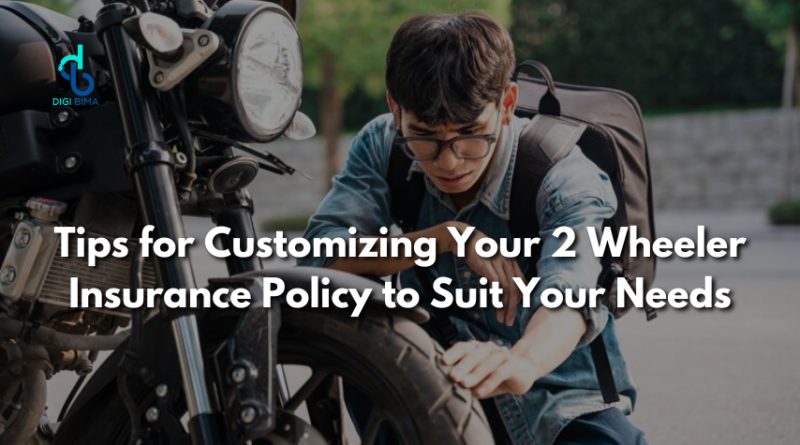Tips for Customizing Your 2 Wheeler Insurance Policy to Suit Your Needs
Owning a two-wheeler is not just about convenience; it’s about freedom, adventure, and practicality. Whether someone is zipping through city traffic or cruising along scenic routes, their two-wheeler is a valuable asset that deserves 2 wheeler insurance.
Protecting it with the right 2 wheeler insurance is crucial. Customizing your insurance policy to suit your specific needs can provide you with optimal coverage and peace of mind. Here are some essential tips for tailoring your 2 wheeler insurance to your requirements.
Understand the Basics of 2 Wheeler Insurance
Before diving into customization, it’s important to understand the basic types of 2 wheeler insurance:
- Third-Party Liability Insurance: This is the most basic and mandatory insurance that covers damages to a third party or their property.
- Comprehensive Insurance: This covers both third-party liabilities and damages to your own vehicle due to accidents, theft, natural disasters, and more.
- Own-Damage Insurance: This is an optional cover that specifically covers damages to your own vehicle.
Assess Your Needs
Evaluate Your Riding Habits
Consider how often and where you use your two-wheeler. If you commute daily through busy city streets, you might want to opt for higher coverage against accidents and theft. If you use your bike occasionally for leisure rides, you might prioritize different coverage aspects.
Example: Anil, a daily commuter in Mumbai, chooses a comprehensive policy with additional accident cover due to the high traffic and increased risk of accidents.
Consider Your Bike’s Value and Age
The age and value of your bike play a significant role in determining the type of coverage you need. Newer, high-value bikes might benefit from comprehensive coverage, while older bikes might only need third-party liability insurance.
Example: Priya, who owns a new high-end sports bike, opts for comprehensive insurance with added theft protection, while Rajesh, with an older model, chooses third-party insurance.
Customizing Your 2 Wheeler Insurance
1. Choose Add-On Covers
Add-on covers enhance your 2 wheeler insurance policy by providing specific protections that are not included in standard policies. Some useful add-ons include:
- Zero Depreciation Cover: This ensures that you receive the full value of any parts replaced without factoring in depreciation.
- Engine Protection Cover: Ideal for areas prone to flooding, this covers damage to the engine due to water ingress or oil leakage.
- Roadside Assistance: Provides help in case of a breakdown or emergency, including towing, minor repairs, and fuel delivery.
- Consumables Cover: Covers the cost of consumables like engine oil, nuts, bolts, and brake oil, which are usually not covered under a standard policy.
Example: Ravi, who lives in a flood-prone area, adds engine protection and roadside assistance to his comprehensive policy to safeguard against water damage and breakdowns.
2. Opt for a Higher IDV (Insured Declared Value)
The IDV is the maximum amount your insurer will pay in case of total loss or theft of your vehicle. Opting for a higher IDV ensures better compensation but might increase your premium. Balance it based on your bike’s current market value and your budget.
Example: Suman opts for a higher IDV for her new luxury bike to ensure she gets adequate compensation in case of total loss.
3. Adjust Your Deductibles
Deductibles are the amount you pay out of pocket before the insurance kicks in. Choosing a higher deductible can lower your premium but increase your out-of-pocket expenses during a claim. Customize this based on your financial comfort and risk appetite.
Example: Ankit, confident in his riding skills and financial stability, chooses a higher deductible to lower his annual premium.
4. Take Advantage of No Claim Bonus (NCB)
The NCB is a discount on your premium for every claim-free year. Protect your NCB with an add-on cover that allows a claim without losing the bonus. This is especially beneficial for safe riders who rarely make claims.
Example: Meera, who has a spotless riding record, adds an NCB protector to her policy to retain her discounts even if she makes a small claim.
How to Choose the Right Insurer
Compare Policies Online
Use platforms like Digibima to compare different 2 wheeler insurance policies. Look for insurers offering the best combination of coverage options, add-ons, and premiums.
Check Insurer’s Reputation
Research the insurer’s claim settlement ratio, customer reviews, and overall reputation. A reliable insurer with a high claim settlement ratio ensures smoother claim processes.
Read the Fine Print
Always read the policy documents carefully to understand the inclusions, exclusions, and terms of coverage. This prevents any unpleasant surprises during claim settlement.
Conclusion
Customizing your 2 wheeler insurance policy ensures you get the best protection tailored to your specific needs and circumstances. By evaluating your riding habits, choosing appropriate add-ons, and using platforms like Digibima to compare options, you can secure a policy that offers comprehensive coverage and peace of mind. Take the time to understand your policy and make informed decisions to protect your valuable asset effectively.
Importance of Disclosing Pre-existing Conditions in Medical Insurance
FAQ Section
Q1: What is the difference between third-party and comprehensive 2 wheeler insurance?
A1: Third-party insurance covers damages to others and their property, while comprehensive insurance covers third-party liabilities and damages to your own vehicle.
Q2: What are add-on covers in 2 wheeler insurance?
A2: Add-ons are additional coverages that can be added to your policy, such as zero depreciation cover, engine protection, and roadside assistance, to enhance your coverage.
Q3: How can I lower my 2 wheeler insurance premium?
A3: You can lower your premium by opting for higher deductibles, maintaining a good riding record to earn No Claim Bonus, and customizing your policy to only include necessary coverages.
Q4: Why should I compare 2 wheeler insurance policies?
A4: Comparing policies helps you find the best coverage options, add-ons, and premiums suited to your needs, ensuring you get the most value for your money.
Q5: How does IDV affect my 2 wheeler insurance?
A5: The Insured Declared Value (IDV) is the maximum amount your insurer will pay in case of total loss or theft of your vehicle. A higher IDV means better compensation but can increase your premium.




